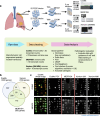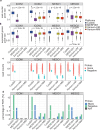Comparison of imaging based single-cell resolution spatial transcriptomics profiling platforms using formalin-fixed paraffin-embedded tumor samples
- PMID: 41006245
- PMCID: PMC12474935
- DOI: 10.1038/s41467-025-63414-1
Comparison of imaging based single-cell resolution spatial transcriptomics profiling platforms using formalin-fixed paraffin-embedded tumor samples
Abstract
Imaging-based spatial transcriptomics (ST) is evolving as a pivotal technology in studying tumor biology and associated microenvironments. However, the strengths of the commercially available ST platforms in studying spatial biology have not been systematically evaluated using rigorously controlled experiments. We use serial 5 μm sections of formalin-fixed, paraffin-embedded surgically resected lung adenocarcinoma and pleural mesothelioma samples in tissue microarrays to compare the performance of the ST platforms (CosMx, MERFISH, and Xenium (uni/multi-modal)) in reference to bulk RNA sequencing, multiplex immunofluorescence, GeoMx, and hematoxylin and eosin staining data. In addition to an objective assessment of automatic cell segmentation and phenotyping, we perform a manual phenotyping evaluation to assess pathologically meaningful comparisons between ST platforms. Here, we show the intricate differences between the ST platforms, reveal the importance of parameters such as probe design in determining the data quality, and suggest reliable workflows for accurate spatial profiling and molecular discovery.
© 2025. The Author(s).
Conflict of interest statement
Competing interests: C.H. declares research funding to institution from Sanofi, BTG, Iovance, Obsidian, KSQ, EMD Serono, Takeda, Genentech, BMS, Summit Therapeutics, Artidis, Immunogenesis and Novartis; scientific advisory board member of Briacell with stock options; personal fees from Regeneron outside the scope of the submitted work. L.M.S.S. declares research funding to institution from Theolytics, advisory role/consulting fees from BioNTech, travel support for participation in 10x Genomic Pathology Day event and participation in NanoString Roadshow event, both unrelated to this work. M.A. declares research funding to institution from Genentech, Nektar Therapeutics, Merck, GlaxoSmithKline, Novartis, Jounce Therapeutics, Bristol Myers Squibb, Eli Lilly, Adaptimmune, Shattuck Lab, Gilead, Verismo therapeutics, Lyell; scientific advisory board member of GlaxoSmithKline, Shattuck Lab, Bristol Myers Squibb, AstraZeneca, Insightec, Regeneron, Genprex; personal fees from AstraZeneca, Nektar Therapeutics, SITC; participation of safety review committee for Nanobiotix-MDA Alliance, Henlius outside the scope of the submitted work. J.Z. declares research funding from Johnson and Johnson, Helius, Merck, Novartis and Summit, honoraria and consulting fees from AstraZeneca, BeiGene, Catalyst, GenePlus, Helius, Innovent, Johnson and Johnson, Novartis, Takeda and Varian outside the submitted work. D.G. has served on scientific advisory committees for Sanofi, Menarini Ricerche, Onconova, and Eli Lilly, and has received research support from Takeda, NGM Biopharmaceuticals, Boehringer Ingelheim and AstraZeneca. T.C. has received over the past 24 months speaker fees/honoraria (including travel/meeting expenses) from ASCO Post, AstraZeneca, Bio Ascend, Bristol Myers Squibb, Clinical Care Options, IDEOlogy Health, Medical Educator Consortium, Medscape, OncLive, PEAK Medicals, PeerView, Physicians’ Education Resource, Targeted Oncology; advisory role/consulting fees (including travel/meeting expenses) from AstraZeneca, Bristol Myers Squibb, Genentech, Merck, oNKo-innate, Pfizer, and RAPT Therapeutics; institutional research funding from AstraZeneca and Bristol Myers Squibb. All other authors declare no competing interests.
Figures








Update of
-
Comparison of imaging-based single-cell resolution spatial transcriptomics profiling platforms using formalin-fixed, paraffin-embedded tumor samples.bioRxiv [Preprint]. 2024 Dec 17:2024.12.13.628390. doi: 10.1101/2024.12.13.628390. bioRxiv. 2024. Update in: Nat Commun. 2025 Sep 26;16(1):8499. doi: 10.1038/s41467-025-63414-1. PMID: 39763763 Free PMC article. Updated. Preprint.
-
Comparison of imaging-based single-cell resolution spatial transcriptomics profiling platforms using formalin-fixed, paraffin-embedded tumor samples.Res Sq [Preprint]. 2025 Jan 17:rs.3.rs-5656204. doi: 10.21203/rs.3.rs-5656204/v1. Res Sq. 2025. Update in: Nat Commun. 2025 Sep 26;16(1):8499. doi: 10.1038/s41467-025-63414-1. PMID: 39877088 Free PMC article. Updated. Preprint.
References
Publication types
MeSH terms
Substances
Grants and funding
- P30 CA016672/CA/NCI NIH HHS/United States
- U24CA224285/U.S. Department of Health & Human Services | NIH | National Cancer Institute (NCI)
- U24 CA224285/CA/NCI NIH HHS/United States
- P50 CA070907/CA/NCI NIH HHS/United States
- P50CA070907/U.S. Department of Health & Human Services | NIH | National Cancer Institute (NCI)
LinkOut - more resources
Full Text Sources
Medical

